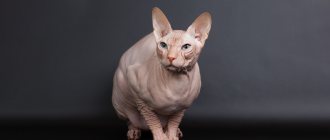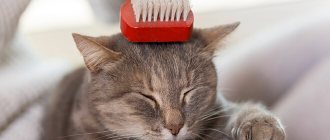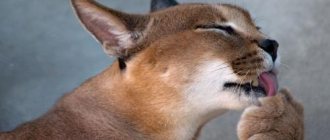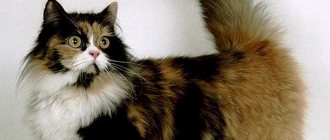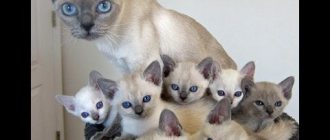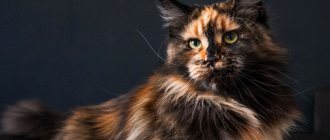Origin story
Singapura cats became known to the world quite by accident, and that was thanks to a person completely far from the world of mustaches and tails. Until the mid-20th century, miniature animals survived on their own on the streets without attracting much attention.
But one day everything changed. A certain geophysicist from the United States of America went on a business trip to Singapore and, amazed by the unprecedented beauty, took several individuals to his wife, a cat lover, and a friend who was already breeding at a professional level. It was these four who became the founders of the Singaporean cat breed.
In 1976, Singapore cats were first shown at an exhibition in the USA, and in 1987 - in Belgium. For several years, new blood was poured into the breed, bringing together Singaporean cats with Abyssinian, Burmese, Siamese and cats of other breeds. In the 90s, such mixing was banned.
The first organization to recognize the breed was the TICA federation (in 1979). In 1982, the CFA included the breed in its lists, and a little later - the World Cat Organization. But FiFa still remains unbending.
By 1991, the Singaporean authorities realized that the popularity of their cats was only to their advantage, and publicly declared them a national treasure of the state, erected a monument and imposed strict restrictions on export from the territory of the state.
The Singaporean breed is rare, and finding the animal is not so easy. There are few nurseries in Russia (in Moscow); they are mainly concentrated in the USA. A baby for home care and with some defects in appearance (i.e. without documents and not for breeding) can be bought for 20,000-30,000 rubles. A show class kitten costs more than 100 thousand rubles.
Purchasing a kitten
When choosing a Singapura kitten, some difficulties may arise. There are not many proven nurseries in Russia that breed Singapura. There are usually few kittens in a litter, a maximum of 4. All this complicates the search for a new pet and makes this breed rare.
Important! You need to wait until the kitten reaches 3-4 months of age to move to a new home and separate from its mother.
You should pay attention to the documents, which should contain information about the pet’s parents, its more distant relatives, and information about vaccinations. Considering all of the above, a Singapura kitten is quite expensive. Prices start from 20,000 - 30,000 rubles. Show class kittens will cost much more, the price for them can reach 250,000 rubles.*
Singapura kitten with mom
Standards
Before the appearance of the Scythian Toy Bob breed, Singapore cats were considered the smallest breed. Their weight does not exceed 3 kg, the individuals are very elegantly built and miniature.
| Standard | Description |
| Head | Small, round, clearly defined muzzle. |
| Ears | Wide, their tips are rounded. |
| Eyes | Large, open, almond-shaped, widely spaced. The iris is all shades of yellow and yellow-green. |
| Torso | Compact but strong, with an arched back and rounded chest. |
| Paws | Medium length, slender, with neat fingers. |
| Wool | The coat is thick, but the hairs themselves are thin and soft and adhere tightly to the skin. |
Disadvantages of the breed:
- ticking on the stomach,
- different eye color,
- no ticking on the head,
- rings on the tail.
Sterilization
If an individual does not meet the stated requirements of the standard, then it must be castrated in order to avoid obtaining a population of a non-standard breed or a breed with obvious defects in physical development. It is safe for young cats to undergo sterilization operations from 8-9 months; if normal weight gain has not occurred, the doctor will postpone sterilization to a later date. But before 2 years of age, surgery must be performed. For cats, similar time frames for sterilization are provided.
Adult cats are more difficult to tolerate operations and anesthesia, the rehabilitation time is also more difficult, and there are risks of postoperative complications.
Cat magnetism
Color
In the United States of America, only one color is allowed as a standard: sepia agouti. The main color of the coat is ivory, the ticking is warm brown (preferably double or even triple ticking on each hair). A clear dark stripe should be visible on the back, and the inside of the legs and the tip of the tail should be colored in the ticking color. The border around the nose is almost black, the nose itself is light salmon.
At home, everything is much simpler: differences in shades are not considered a defect.
In the photo there is a mother Singapura cat and her kitten
Appearance
The appearance of the cat gives the impression of a wiry teenage cat. Cats retain these physical characteristics until old age, so they can frolic like kittens even in old age. This breed has fairly elastic joints that are not prone to injury compared to other breeds. There are a whole lot of colors.
Head
The skull is small, rounded, and the muzzle is triangle-shaped. The chin is clearly expressed by straight lines and sharp features. Beautiful and large ears are slightly pointed at the top, but there are no tufts on the ears.
Sight
Weight
It is important to monitor the diet of such representatives of the species. Weight affects the animal’s health and well-being. It is recommended to feed cats a variety of foods.
Frame
The body of the Singaporean is rectangular, elongated and large muscle groups are clearly visible. The tail and limbs look sophisticated and graceful due to their short fur and muscularity.
By all parameters
Color
This indicator may differ from the stipulated standard, for example, in the CFA requirements, cats of the breed must have ivory-colored hair. Light and darker shades of standard agouti sepia are acceptable. The color of the hairs themselves matters. All fur at the base should be light, gradually darkening towards the top. There are at least two stripes of dark color on the body of the hair, with light spaces between them.
The tail should be darker at the end, but smoothly follow the color gradient in a straight line towards the ridge. A stripe of a darker shade may run along the spine. Light brown shades should cover the chest, muzzle and chin of the individual. The belly should be warm in color.
On the inside of the limbs, not clearly defined stripes of a darker shade are allowed. On the soles, between the pads, there should be rich brown wool.
Salmon shades (from light to dark) should edge the nose of the individual. The nostrils should have darker colors. The eyes are also emphasized by stripes of darker fur, as if lined with a pencil. The cheek areas also feature more contrasting colors.
The breed has a cheetah pattern on its face. These bands are considered acceptable and fit the description of the standards.
With a cheetah pattern on his face
Singapura cat color
Dark brown ticking
Character and behavior
Singapura cats are peaceful and calm creatures. You can, without fear, have them in families with very young children: they treat children very carefully, not allowing themselves to show aggression towards them. They will be happy to play with the crumbs, but if the child indulges too much, they will quietly sneak away and hide.
However, kittens and teenagers can boast of playfulness, while adults prefer a quieter pastime: lying on the windowsill and looking at pigeons on the balcony, or watching you knead dough. They are curious, but in moderation: they will not jump after a bird from the balcony, just as they will not stick their nose into a boiling pan. They have a well-developed sense of danger, so Singapura cats will even prefer to play it safe.
They are afraid of strangers and prefer to get to know them from a distance: sitting on a closet or under the sofa. Getting used to a new place takes a long time and is difficult. They cannot stand loneliness and may even get sick from boredom.
Clean and tidy. The filling is not thrown out of the tray, food is not pulled out of the bowl. Not vindictive, but touchy. If you crush your tail, you will have to apologize for a long time and atone for your guilt with goodies and strokes.
They are thermophilic, so they will strive to crawl under the owner’s blanket. If you are against this, buy your pet a bed in the shape of a house, place it closer to the radiator and lay a warm blanket inside.
They make very caring and attentive parents, and they calmly raise not only their own, but also other people’s kittens.
Obedient and learn quickly. They can easily be taught to use the toilet, open door handles and even flush water.
Reviews from owners of Singapura cats
Nadezhda, Kazan:
“We recently purchased this little miracle. Our cat is incredibly beautiful, smart, and immediately began using the tray for its intended purpose. The children have a lot of fun with it; they play all day long. “He eats mostly dry food, doesn’t play around too much, all the vases are intact.”
Dmitry, St. Petersburg:
“Our cat is already 4 years old, but he looks almost like a kitten. Very well-mannered, doesn't like to make a mess. He gets along well with Funtik (a British cat), and does not show any aggression. A little cowardly, afraid of sharp sounds, but I think many cats are like that. In general, he is our favorite, loves to be with his family, and waits to be petted. In general, we are happy with the breed; we have a very smart and adequate cat.”
Yana, Moscow:
“I have been looking for a cattery for Singapore cats for a very long time. Then there was still waiting for my cat to grow up, and finally, I became the owner of a miniature kitten. Darcy has been living with us for six months now, and I can say that I have never met a more affectionate cat. She follows me around, maybe even insistently demands attention. She eats in moderation, but her weakness is meat. We feed mainly with industrial food, sometimes we bring herbs from the street to chew, so our house plants are intact. I haven’t noticed any shedding as such, but I brush it out regularly. The tray recognized it immediately. Darcy is quite smart, but she can manipulate and gets what she wants. In general, a cat with character.”
The Singapura cat is a loyal, loving friend. The pet will find an approach to all household members. His expressive look and beautiful shiny fur will not leave anyone indifferent. The main thing is to love and care for your pet, then he will reciprocate.
*Prices are current as of October 2021
Care instructions
They do not require special care. All you need to do is brush your pet’s fur with a soft brush once a week (twice during shedding), remove wax accumulated there from the ears, and brush your teeth a couple of times a month. But use special products for this: not from your shelves, but from a pet store.
Does your cat like to swim?
Not really
Singapura cats do not need to trim their claws; they can handle this task themselves, but just in case, we advise you to read how to trim a cat’s claws. They absolutely do not like to bathe, so it is better for you to find a compromise: choose a good dry shampoo, for example.
Pros and cons of the breed
Cats have positive parameters:
- this breed is quite charismatic;
- has the most flexible character and does not show aggression;
- quickly becomes attached to its owner, but does not distract unless there are compelling reasons for this;
- they are clean, take care of their appearance regularly and with enviable regularity;
- direct care and maintenance of a friend does not cause difficulties on the part of the owner;
- attract attention to themselves with their voice quite rarely;
- They will always find a way to play with other pets living in the apartment.
But there are a number of negative characteristics:
- choosing a kitten on your own without the necessary knowledge and experience is quite difficult;
- cats are active, energetic, and sometimes show their restlessness excessively.
Cats are always wary, overly fearful of everything new.
Singapura cats are active and energetic
Catering
A good metabolism does not allow lazy Singapura cats to gain weight even with a large meal. But don’t try to feed your pet until he’s a volleyball: it won’t do him any good. The serving size depends on the age, well-being and lifestyle of the animal, but the average for a female is 50-60 kcal, for a male - 60-70 kcal (per 1 kg of weight - 40-60 grams of food).
If a Singapura cat constantly begs for food, this does not mean that it is malnourished. The cause may be a disease of the digestive system, parasites, or a sharp increase in blood sugar. Show the animal to the veterinarian and do not refuse tests.
There should be 2 feedings: morning and evening. After each meal, bowls should be washed to prevent food from turning sour. The water is also changed 2 times a day. You cannot drink tap water - only settled or purified water using a filter.
Twice feeding applies to adult cats older than one year. From 9 months to a year they eat 3 times, from six months to 9 - 4-5 times, up to six months - 5-6 times.
Natural products
It is prohibited to give:
- roast,
- salty,
- fatty,
- smoked,
- pickled,
- sweet,
- many vegetables and fruits (eggplant, avocado, citrus fruits, grapes, tomatoes, white cabbage),
- chicken protein,
- products with artificial colors, flavor enhancers, pieces of fruit, GMOs.
Allowed:
- lean meat (beef, rabbit, veal, turkey, chicken),
- fish (flounder, hake, trout, salmon, halibut),
- dairy products (yogurt, sour cream, cottage cheese, cream, fermented baked milk, hard cheese),
- porridge (rice, buckwheat, millet, oatmeal),
- boiled chicken yolk,
- vegetables (zucchini, carrots, pumpkin, broccoli, asparagus, greens),
- vegetable oils (olive, sunflower, flaxseed).
Recommended food
Among ready-made foods, breeders recommend exclusively holistic foods such as Acana, Farmina N&D, Wildcat and super-premium Natyka, Superpet.
Below are the recommended holistic class foods. Links with the names of the food are clickable, on them you can, within our website, read the descriptions of the food and read reviews from owners of Singapore breed cats.
| Holistic | Holistic | Super premium |
| AATU | Riverwood | Summit |
Hygiene
Bathing the animal on an ongoing basis is not required. The owner is obliged to keep the eyes and ears clean. As they become dirty, you need to wipe your eyes and ears with clean napkins to avoid infection of the mucous membranes with pathogenic microbes. Dangerous colonies of bacteria quickly develop in pollution, which can harm the health of an individual. The owner trims the nails in a timely manner. Perhaps it will be possible to install a scratching post, the cat will do its own claws without the influence of the owner. Combing is required once every 7-14 days; for this purpose, a special brush with small and frequent teeth is provided.
Cats must undergo timely examinations by a veterinarian and receive the required vaccinations.
The owner is obliged to maintain a deworming calendar for the animal and give the required medications in a timely manner.
Diseases
Despite its external fragility, this breed is considered one of the healthiest. To date, she has no known genetic diseases. But short fur does not retain heat well, so it is important to ensure that your four-legged friend does not catch a cold. Protect your pet from drafts, do not allow it to sleep under an open window, dry it with a hairdryer after water treatments, and for walks on cool days, be sure to buy a warm cat suit.
Vaccinations and deworming are mandatory procedures if you care about the health of your big-eyed furry. Modern vaccines (Quadricat, Nobivak, Leukorifelin, Multifel) make it possible to protect an animal not from one, but from several dangerous diseases at once. The first vaccination is given at 9-12 weeks (at 6 weeks if necessary), then once a year.
Deworming is carried out once a quarter. Exceptions: kittens under 6 months, pregnant women, animals with infectious diseases.
Description of the breed
The species in question has some distinctive characteristics; in addition to its small size, cats are quite inquisitive. They do not want to bother their owner, but when faced with an object or phenomenon for the first time, they will study it for a long time, and if that doesn’t work out, they will try to accept the innovation and not spoil their mood. This trait is common to all island cats.
Owners and breeders focus on the charm and magnetism of cats; they want to be protected and protected, like little kittens, because their size at first makes them want to feed them more.
Handsome man with yellow eyes
Standardization of this breed was carried out in the 80s of the last century. Communities of phenologists massively recognized the breed in official status, which made it possible to fully standardize it already in 1981. In 1988, for the first time, a cat of the Singapore breed became an official, well-deserved holder of the champion title and status.
Photo gallery
Below are photos of Singapore breed cats.
Your own corner
Animals actually love cozy pillows, or rather, what is important to them is not comfort, but detachment, isolation from possible danger and warmth. Cats also need to be alone from time to time; they cannot constantly shower their owner with love and affection, even this Singaporean cat breed. The animal will use a special house, but only if it feels safe in it. It is necessary to equip a special warm place, then the owner will know where to find the animal. However, in most cases, the cat will want to spend time with the person, and will use the corner while the owner is not at home.
In its place
Animal temperament
Singupuris are cautious with strangers, they are in no hurry to get to know each other, but they also do not shock them with their crazy antics. Pampering is not their style. They flirt when it is expected of them. Breeders note the friendly nature of Lilliputians. They know how to show their tenderness in response to shown care. However, they always remain unconvinced and make decisions independently.
They are particularly caring; if there are children at home, they will take care of them. They lead an active lifestyle, even if no one pays attention to them, they have fun. They get along with other animals: dogs, cats, parrots, hamsters.
The breed is characterized by a lack of aggression. The kitten will always find something to do or simply go to rest.
Easy to train, quickly begins to respond by name. Excellently picks up the owner's commands. The cat meows quietly and does not cry unnecessarily. Lilliputians are ready to accompany the breadwinner on their heels, they love to sleep nearby and bask
The miniature beauty knows how to attract the attention of adults and children
The Singapura cat can play if it is expected of her.
Singapuras get along well with other cats
Health
The Singapura develops slowly, reaching maturity only at two years of age. Babies begin to be distributed from the nursery at three months and later. Cats are strong, active, and curious. Rarely, increased sensitivity to vaccination has been observed.
Breeders warn that Singapore cats are badly affected by the cold, so it is worth limiting their time outdoors and getting vaccinations up to date.
The ancestors of modern Singaporeans had excellent health and strong immunity. Even after experiments by breeders, cats remain strong and resistant to many diseases. Genetic pathologies appear only as a result of closely related crossings.
Learning ability
When it comes to learning ability, Singaporeans are up to the challenge! Since they love being around their favorite people, are attentive and focused, training with them is a pleasure.
When it comes to workout needs, these babies can fool you. Singapuras are little fluffy balls of energy and it is important for them to get enough play, jumping and prancing every day to stay healthy. If the family is large, it is advisable that everyone takes part in this. This will provide many of the short, intense play “sessions” that cats need. And this will give everyone the opportunity to spend quality time with their pet.
Breeding
The breeder must understand that he does not have the right to cross the animal with other breeds, since the true number of pure breed individuals is small. When choosing a female or male for breeding, you need to make sure that there is no closely related relationship with a specific applicant. Breeders are obliged to understand the importance of genetic diseases of the breed and resort to preventive measures to eliminate them.
Females can normally bear and give birth to offspring at the age of 3 years, males can mate from the age of 2, subject to normal physical development.
With a kitten

